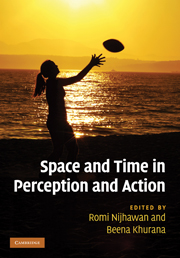Book contents
- Frontmatter
- Contents
- List of contributors
- Acknowledgments
- 1 Space and time: the fabric of thought and reality
- Part I Time–space during action: perisaccadic mislocalization and reaching
- 2 The internal eye position signal, psychophysics, and neurobiology
- 3 Factors influencing perisaccadic visual mislocalization
- 4 Visual and nonvisual factors in perisaccadic compression of space
- 5 Keeping vision stable: rapid updating of spatiotopic receptive fields may cause relativistic-like effects
- 6 Combined influences of extraretinal signals, retinal signals, and visual induction on space perception and manual behavior in perisaccadic and steady viewing
- 7 Space constancy: the rise and fall of perceptual compensation
- 8 Intercepting moving objects: do eye movements matter?
- 9 The utility of visual motion for goal-directed reaching
- Part II Temporal phenomena: perception
- Part III Temporal phenomena: binding and asynchrony
- Part IV Spatial phenomena: forward shift effects
- Part V Space–time and awareness
- Index
- References
4 - Visual and nonvisual factors in perisaccadic compression of space
from Part I - Time–space during action: perisaccadic mislocalization and reaching
Published online by Cambridge University Press: 05 October 2010
- Frontmatter
- Contents
- List of contributors
- Acknowledgments
- 1 Space and time: the fabric of thought and reality
- Part I Time–space during action: perisaccadic mislocalization and reaching
- 2 The internal eye position signal, psychophysics, and neurobiology
- 3 Factors influencing perisaccadic visual mislocalization
- 4 Visual and nonvisual factors in perisaccadic compression of space
- 5 Keeping vision stable: rapid updating of spatiotopic receptive fields may cause relativistic-like effects
- 6 Combined influences of extraretinal signals, retinal signals, and visual induction on space perception and manual behavior in perisaccadic and steady viewing
- 7 Space constancy: the rise and fall of perceptual compensation
- 8 Intercepting moving objects: do eye movements matter?
- 9 The utility of visual motion for goal-directed reaching
- Part II Temporal phenomena: perception
- Part III Temporal phenomena: binding and asynchrony
- Part IV Spatial phenomena: forward shift effects
- Part V Space–time and awareness
- Index
- References
Summary
Summary
The perceptual stability of visual space becomes fragile in the wake of a saccadic eye movement. Objects flashed shortly before a saccade are mislocalized toward the saccade target. Traditional accounts for this effect have associated the mislocalizations with sluggishness of the efference copy signal, which is important in space perception across eye movements. Recent theories of space perception, however, have emphasized a role for visual memory in the generation of transsaccadic spatial stability. We have investigated the role of visual processes and their interactions with efference copy signals in the perisaccadic compression of space. In our experiments, subjects performed saccades in front of a computer display while visual stimuli were briefly flashed on the screen just before or during the saccade. Subjects had to report the perceived location of the flash. When the saccade target's position was visibly available after the saccade, the perceived location of the flash was compressed toward the target's position. This compression occurred not only along the axis of the saccade but also for parts of visual space along a direction orthogonal to the saccade. When the saccade target was not visibly available after the saccade, the perceived location of the flash showed only a slight shift in saccade direction. In this condition, however, the perceived location of the saccade target was drawn toward the position of the flash. We propose a framework that consists of pre- and postsaccadic processes to explain these findings.
- Type
- Chapter
- Information
- Space and Time in Perception and Action , pp. 38 - 51Publisher: Cambridge University PressPrint publication year: 2010
References
- 2
- Cited by



